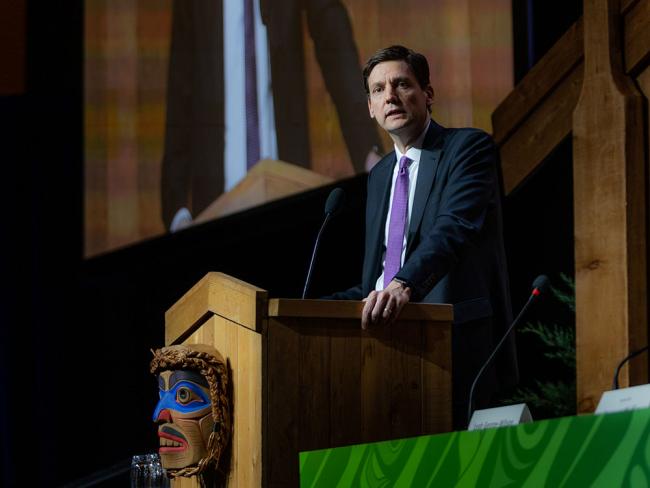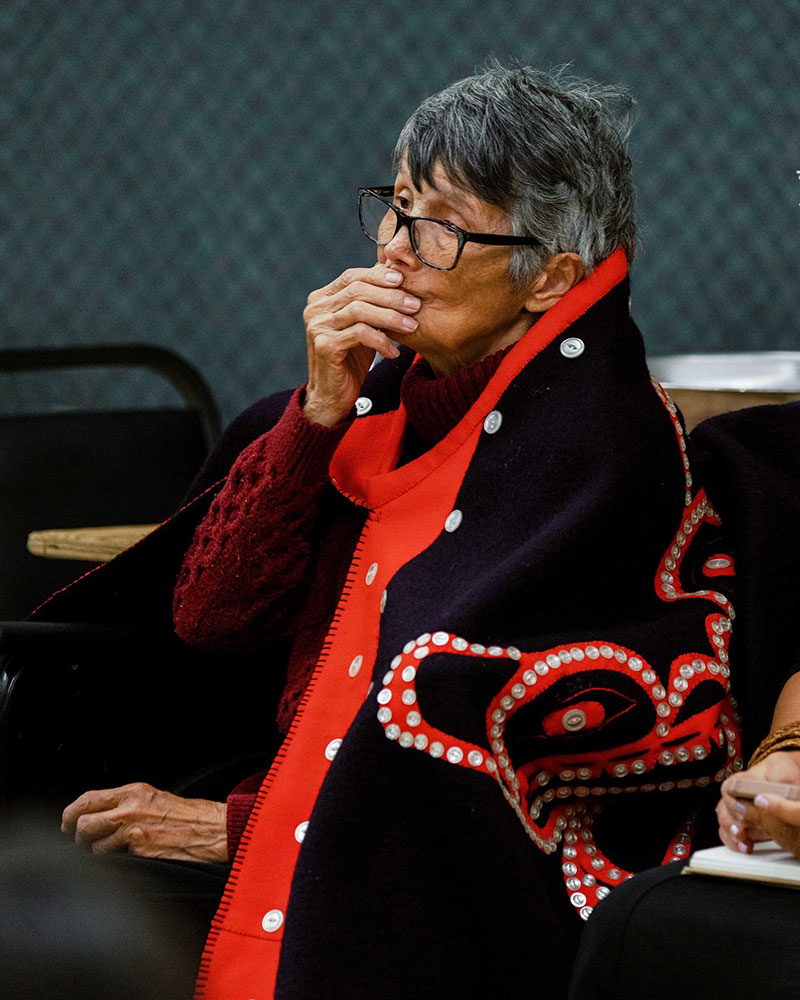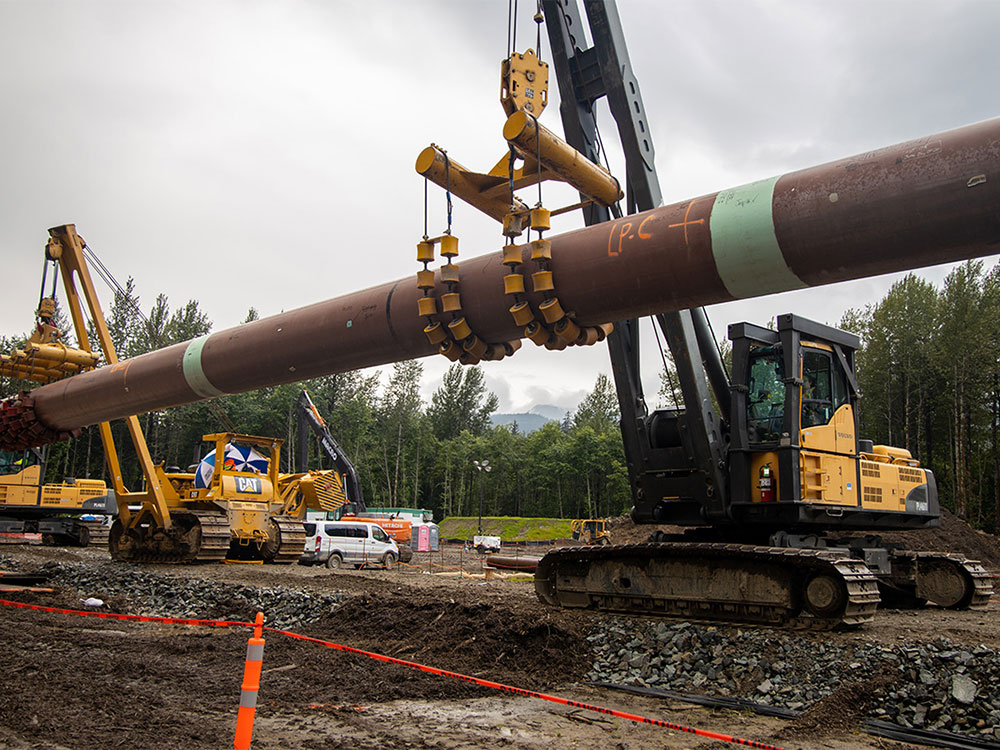Articles Menu

Nov. 30, 2022
At the recent COP27 conference in Egypt, B.C. Environment Minister George Heyman was asked about the future of liquified natural gas in B.C.
The question came during a virtual media conference hosted by the BC Assembly of First Nations and members of a First Nations delegation to the annual gathering on climate change.
Heyman appeared to sidestep.
“First of all, I want to clarify, I have never said, and I don’t believe our government has said, that LNG is a good way to bring down emissions,” he said. “We inherited a number of certificated projects and one had the support of the government to go forward.”
Coastal GasLink has become a flashpoint for environmental concerns and Indigenous rights in the province, with the project proceeding despite opposition from Wet’suwet’en Nation hereditary leadership. Roughly a quarter of the pipeline, which began construction in 2019, crosses the nation’s traditional territory.
Attempts by the Wet’suwet’en and their supporters to block pipeline construction led the B.C. Supreme Court to issue an injunction to Coastal GasLink, sparking several high-profile police actions, dozens of arrests and nationwide solidarity protests. RCMP costs for policing the conflict surpassed $25 million earlier this year.
The province has maintained its support of Coastal GasLink. Former premier John Horgan has said that the project is “fully permitted” and that B.C.’s implementation of the Declaration on the Rights of Indigenous Peoples Act, which passed in October 2019, is “forward looking.” The declaration requires government to obtain the free, prior and informed consent of Indigenous communities before making decisions that affect them.
It’s unclear whether the provincial government and B.C.’s new premier, David Eby, would apply the same approach to three additional gas pipelines currently authorized for the province’s north.
“I’ve spoken to the premier designate about our climate plan and I know that we’ve said for quite some time that oil and gas developments have to fit within our climate plan and meet our legislative targets,” Heyman said at COP27, days before Eby took office. “I think what we need to do is tell British Columbians and Indigenous Peoples the exact measures that we’re going to propose to meet those targets and I expect that we will be doing that relatively quickly.”
The Tyee made repeated requests to the premier’s office for comment on whether he would support more pipeline development in the North. The requests were forwarded to the Ministry of Energy, Mines and Low Carbon Innovation, which said it consulted with several other ministries before providing its response — a link to the BC Oil and Gas Commission’s website.
“The status of each project and permits issued thus far can be found on the respective project pages on the Commission’s website,” the response reads in full.
The Tyee’s legislative reporter asked Eby about his views on LNG development in September, during his campaign to become BC NDP leader. Eby declined to answer, saying his climate plan would be released the following week.
But the campaign was cut short in October when the BC NDP’s provincial executive disqualified the only other candidate, Anjali Appadurai, a climate campaigner accused of breaking campaign rules, and the Eby campaign never announced its platform on climate and the environment.
Eby has yet to release a climate policy or publicly discuss liquified natural gas development since taking office.
It’s unclear how the province might proceed given the three proposed pipelines all hold environmental certificates, yet also face potential opposition from northern Indigenous communities.
Shannon McPhail, executive director of Skeena Watershed Conservation Coalition, said the province shouldn’t be moving ahead with more pipelines until it has addressed existing conflicts and environmental issues with Coastal GasLink. In addition to Indigenous opposition, the project has been issued nearly $250,000 in fines for damage caused to watersheds.
“It is completely irresponsible to even entertain the idea of other pipelines through this incredible, iconic salmon-bearing watershed when the issues with CGL are so terrible, without resolution. With the way that things have changed since those other pipelines have been permitted, how can we even consider entertaining this?” McPhail said.
Of the three pipelines authorized for the North, Pacific Trail and Westcoast Connector are owned by Enbridge and the third, Prince Rupert Gas Transmission pipeline, is owned by TC Energy Corp., the company currently building Coastal GasLink. All three have their environmental assessment certificates, a blanket authorization allowing the pipelines to move forward. More detailed planning — and permitting — will take place as the projects progress.
The Tyee requested interviews with both Enbridge and TC Energy, but neither made someone available to answer questions.
In an email to The Tyee, Enbridge said its two northern B.C. pipeline projects are in the early stages of development and that no final investment decision has been made on whether they will move forward. TC Energy said it is reviewing its options after the export terminal its proposed pipeline would connect with in Kitimat was cancelled five years ago.
The pipelines would cross the territories of dozens of Indigenous nations. Impact benefit agreements, such as those signed with First Nation band councils along the Coastal GasLink corridor, have been used as evidence of support by both the province and industry.
Among the territories that the three pipelines would cross are Wet’suwet’en yintah and Gitxsan laxyip. The neighbouring nations jointly fought the Delgamuukw-Gisday’wa court case, which ended 25 years ago with the Supreme Court of Canada acknowledging on appeal that they had never relinquished title to their territories.

The Gitxsan Nation alone is made up of more than 60 house groups, or wilps, each governing its own territories. According to Wilps Gwininitxw member Ankhla Jennifer Zyp, a spokesperson for her mother, Simogyet (Chief) Gwininitxw, who also goes by Yvonne Lattie, while some local government staff have recognized the authority of individual Gitxsan wilps, hereditary leadership has hit a brick wall when trying to engage with the province at a higher level.
After watching the events that have unfolded on nearby Wet’suwet’en territory, it’s a cause for concern, Zyp said.
“We’re worried, for sure, that we’re going to be met with the same violence, with the same push from the government,” she said. “We’re concerned about how these pipelines crossing all these rivers are going to affect the salmon returning back to our territory.”
In August, Wilps Gwininitxw declared its traditional territories in the upper Skeena Valley an Indigenous protected area under Gitxsan law. The Gwininitxw Indigenous Protected Area is 170,000 hectares encompassing pristine wilderness that includes important wildlife habitat, unique wild salmon populations and Indigenous cultural heritage.
The protected area is just upstream from the proposed route of two pipelines and Zyp said the wilp felt the need to move forward with protection independent of government.
“In the absence of meaningful provincial or federal government action to protect the Skeena watershed from industrial development, Wilps Gwininitxw is unilaterally declaring their territories protected,” the wilp said in a statement at the time.

Under B.C.’s Environmental Assessment Act, the environmental assessment certificates for the three pipelines currently on the books give the companies 10 years to have “substantially started” a project, a timeframe that includes a one-time five-year extension to its certificate.
Each of the three pipelines has received an extension to its certificate. Only one, Enbridge’s Pacific Trail pipeline, is considered “substantially started,” locking in its authorization indefinitely.
Pacific Trail would take a similar route to Coastal GasLink and is the only one of the three to cross Wet’suwet’en territory on its 470-kilometre journey from north of Prince George to Kitimat. Originally proposed in 2005 as a 24-inch-diameter pipeline, it was approved in 2008 at 36 inches and amended in 2012 to a 42-inch pipe.
In a May 2008 report outlining its reasons for approving the project, B.C.’s Environmental Assessment Office noted Wet’suwet’en concerns, adding the nation’s hereditary leadership had written a letter in 2006 saying it “did not support the development of a pipeline through the culturally important areas in the Morice Lake/Gosnell Creek area.”
“The Office of the Wet’suwet’en have taken a position that no level or risk of impact is acceptable to water quality, and hence to fish and fish habitat, in the Morice Watershed Management Area and therefore they remained opposed to the project,” the province’s report said.
Nevertheless, in issuing Pacific Trail’s certificate, the province concluded that the crown had “fulfilled its obligations for consultation and accommodation to First Nations.”
Recent compliance reports submitted to the province by Enbridge for the Pacific Trail pipeline indicate its current activities are limited to “maintenance and preservation activities” in areas where construction has taken place.
The project hit a hiccup when its intended termination point, the Kitimat LNG export facility, was cancelled by Chevron in 2019.
Despite the setback, Enbridge bought Pacific Trail earlier this year from Chevron and Woodside Energy, inheriting the project’s environmental certificate and impact benefit agreements signed with First Nations.
Enbridge also owns a second pipeline project slated for the region, Westcoast Connector Gas Transmission pipelines, which it acquired when it merged with Spectra Energy in 2017. The project would entail twin pipelines, each 48 inches in diameter, and follow a more northerly 850-kilometre route from northeast B.C. to the Ksi Lisims LNG facility being developed by the Nisga’a Nation north of Prince Rupert.
The route is similar to that proposed for the Prince Rupert Gas Transmission pipeline, which would travel 900 kilometres from the northeast to near Prince Rupert. Both projects received their certificates in November 2014, and both certificates were extended by the EAO in 2019, taking the pipelines’ current expiration dates to November 2024.
Enbridge says it is “actively developing” Westcoast Connector and has indicated it would like a further extension to the certificate, which could take the project’s deadline to substantially begin until November 2029.
A spokesperson for B.C.’s Ministry of Environment and Climate Change Strategy said the EAO hadn’t yet received a formal application for extension from the company.
Earlier this year, Enbridge also applied for an amendment to the project route that, if approved, would omit the easternmost 138 kilometres to avoid Blueberry River First Nations territory, where a 2021 B.C. Supreme Court decision determined the province had breached the nation’s treaty rights by not considering the cumulative impacts of natural resource development.
It’s just one example of how B.C.’s political and environmental landscape has changed over the past decade.
Other changes, said Tara Marsden, a Gitanyow wilp member who holds the traditional name Naxginkw, include the passing of B.C.’s Declaration on the Rights of Indigenous Peoples Act, the increased effects of the climate crisis and the buying and selling of projects between companies.
“It’s almost a decade later and climate change is much more significant and the treatment of our neighbours, the Wet’suwet’en — our Chiefs have gone and supported the Wet’suwet’en many times in their defence of their land on Coastal GasLink,” said Marsden, who acts as a consultant to the nation’s hereditary leadership.
“It really needs to be treated like a brand-new project, if they want to restart it.”
Today, Westcoast Connector would also be subject to the Gitanyow Wilp Sustainability Assessment Process, an environmental assessment process the nation undertakes parallel to the province’s.
Westcoast Connector was first proposed by Spectra Energy on the heels of Enbridge’s Northern Gateway pipeline, a diluted bitumen pipeline roundly opposed by northern communities. By comparison, the gas pipeline, which would cross 50 kilometres of Gitanyow territory, was seen as less risky and Gitanyow Hereditary Chiefs were open to engaging in the process, Marsden said.
In approving Westcoast Connector, the B.C. EAO acknowledged Gitanyow’s concerns about the project, saying the nation had advised in an August 2014 letter to the ministry that “no approvals leading to the alienation or exploitation of resources within the Gitanyow Lax’yip would be allowed without the express consent and authorization of Gitanyow under threat of court action.”
More broadly, the provincial regulator said that it had heard “extensive concerns expressed by almost all of the Aboriginal groups regarding the volume and pace of work associated with the consultation and review of multiple LNG projects.” It added that some First Nations felt their concerns “were not captured or were mischaracterized by EAO.”
Yet, in granting the certificate, the EAO again said it was “satisfied that the Crown’s duty to appropriately consult and accommodate Aboriginal groups” had been met.
Today, Enbridge is “eager” to engage with Gitanyow on its plans to extend Westcoast Connector’s certificate, Marsden said. But given the new owner’s history in the region, and other changes over the past decade, she said the province would need to recognize the “material changes” that have occurred, sparking a new environmental assessment process.
Enbridge has also been meeting with other Indigenous groups along the pipeline route, including Wilps Gwininitxw.
Zyp recently attended a public meeting between Enbridge and Gitxsan Hereditary Chiefs and agrees that a new assessment should be required.
“What they were saying was basically they want approval to extend that environmental certificate,” she said. “We were arguing that they should have another environmental assessment, because in 2014 things were a lot different than 2022.”
In an email to The Tyee, Enbridge said both its potential projects in northern B.C., Westcoast Connector and Pacific Trail, are still in early stages of development and no decisions have been made on timing or whether they will proceed.
“At this stage, we’re engaging with Indigenous nations to better understand their perspective and we have not confirmed any commercial partners,” Enbridge media relations strategist Jesse Semko said. “We will continue to discuss these two projects with Indigenous nations and local communities to evaluate opportunities relating to the development of LNG in B.C.”
The company did not respond to a followup question about whether it would cancel or reroute the projects if they face opposition from Indigenous groups.
Following a similar route to Westcoast Connector, TC Energy’s 900-kilometre, 48-inch diameter Prince Rupert Gas Transmission line would also begin in the northeast and connect with a terminal near Port Edward — though, like Pacific Trail, the LNG facility planned for its terminus has also been cancelled.
In an email to The Tyee, TC Energy media relations said it continues to review options around Prince Rupert Gas Transmission pipeline since Malaysian-owned Petronas pulled out of the planned Pacific NorthWest LNG facility in 2017.
“With this, we continue to review our options related to our permitted PRGT project,” the company said.
Like the other projects, when approving Prince Rupert Gas Transmission line, the EAO acknowledged “extensive concerns from almost all of the Aboriginal groups” regarding pace and scale of LNG development in the region, but ultimately concluded that it had met its duty to consult and accommodate Indigenous groups.
In an April 2019 report granting its certificate extension, the EAO determined that there was no “material change with consequences to Indigenous groups’ exercise of their Aboriginal Interests and treaty rights” and that it was satisfied that the Crown had met its duty.
McPhail, who wrote a scathing letter on behalf of Skeena Watershed Conservation Coalition as the EAO considered the extension request, said the province needs to work out basic oversight roles before it moves forward with other projects.
For two months, the SWCC director said she has been trying to get answers about Coastal GasLink’s current drilling under the Morice River, a culturally and spiritually significant waterway known to the Wet’suwet’en as Wedzin Kwa. With salmon currently in the river, she said there are outstanding questions about who is providing fisheries monitoring.
She said her questions have met with confusion and deflection, with provincial and federal regulators like the EAO, the BC Oil and Gas Commission and Fisheries and Oceans Canada sending her in circles as she seeks answers.
Until simple questions around permitting, monitoring and enforcement are addressed, she said future pipeline development in the province should be on hold.
“We’ve got the biggest investment in Canada happening in our backyard and the government agencies don’t know who’s responsible,” McPhail said.
“We can’t move forward. There’s the issue of dealing with the stuff on the table right now with Coastal GasLink and we haven’t figured that out yet. How can we possibly entertain more pipelines?
Amanda Follett Hosgood is The Tyee’s northern B.C. reporter. She lives in Wet’suwet’en territory.
[Top photo: BC Premier David Eby, who spoke Tuesday at the opening of the First Nations Leaders’ Gathering, has shared few details about his climate plans since taking office almost two weeks ago. Photo via BC government.]